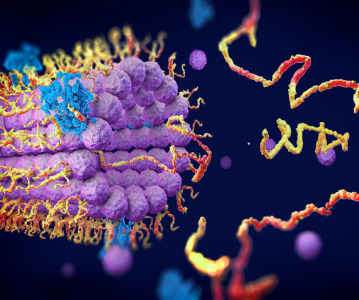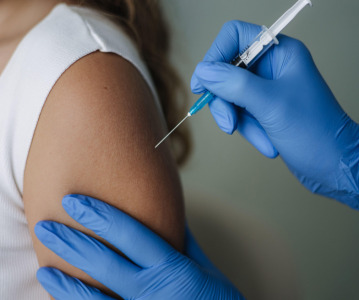Spinraza meets primary endpoint at interim analysis of Phase III study in later-onset SMA

Biogen is preparing for the potential launch of Spinraza in the US possibly as early as the end of 2016.
Biogen and Ionis Pharmaceuticals have announced that Spinraza (nusinersen), an investigational treatment for spinal muscular atrophy (SMA), met the primary endpoint at the interim analysis of CHERISH, the Phase III study evaluating Spinraza in later-onset (consistent with Type 2) SMA. The analysis found that children receiving Spinraza experienced a highly statistically significant improvement in motor function compared to those who did not receive treatment. Spinraza demonstrated a favorable safety profile in the study.
These results, along with our successful trial in infantile-onset SMA, reinforce the potential of SPINRAZA to benefit a broad range of SMA patients,” said Michael Ehlers, executive vice president, head of Research and Development at Biogen. “We will make regulators around the globe aware of this data and will continue working closely with them to bring Spinraza to families affected by SMA as quickly as possible.”
Biogen is preparing for the potential launch of Spinraza in the US possibly as early as the end of 2016 or the first quarter of 2017.
CHERISH is a 15-month study investigating Spinraza in 126 non-ambulatory patients with later-onset SMA (consistent with Type 2), including patients with the onset of signs and symptoms at greater than 6 months and an age of 2 to 12 years at screening.
Results from the primary endpoint of the pre-specified interim analysis demonstrated a difference of 5.9 points at 15 months between the treatment and sham-controlled study arms, as measured by the Hammersmith Functional Motor Scale Expanded (HFMSE). From baseline to 15 months of treatment, patients who received Spinraza achieved a mean improvement of 4.0 points in the HFMSE, whereas patients who were not on treatment declined by a mean of 1.9 points. The HFMSE is a reliable and validated tool specifically designed to assess motor function in children with SMA, and a change of three points or greater in the HFMSE has previously been identified as clinically meaningful. Data from the other endpoints analysed were consistently in favour of children who received treatment. Spinraza demonstrated a favourable safety profile. The majority of the adverse events were considered to be either related to SMA disease, common events in the general population, or events related to the lumbar puncture procedure. No patients discontinued the study. With the positive interim analysis, the CHERISH study will be stopped and participants will be able to transition into the SHINE open-label extension study to receive Spinraza. Full study results will be presented at future medical congresses. “These data further validate the potential of Spinraza as a treatment for patients with SMA,” said B. Lynne Parshall, chief operating officer of Ionis Pharmaceuticals. “We are grateful to all the families and clinicians who have participated in all of the Spinraza studies. Without their commitment and support, this program would not have been able to progress so quickly.” FDA recently accepted the company’s New Drug Application (NDA) for Spinraza as a treatment for SMA and communicated they plan to act early on the NDA under an expedited review. In addition, the EMA recently validated Biogen’s Marketing Authorization Application (MAA) in the EU. The EMA’s Committee for Medicinal Products for Human Use (CHMP) granted Accelerated Assessment status and the FDA granted Priority Review to Spinraza. Biogen is initiating regulatory filings in other countries in the coming months. Biogen initiated a global expanded access program (EAP) in infantile-onset SMA earlier this year. The company will continue to explore where and when the EAP may be broadened to include patients with later-onset SMA (consistent with Type 2).Related News
-
News A Day in the Life of a Start-Up Founder and CEO
At CPHI we work to support Start-Up companies in the pharmaceutical industry and recognise the expertise and innovative angles they bring to the field. Through our Start-Up Programme we have gotten to know some of these leaders, and in this Day in the ... -
News Biopharmaceutical manufacturing boost part of new UK government budget
In their national budget announced by the UK Labour Party, biopharmaceutical production and manufacturing are set to receive a significant boost in capital grants through the Life Sciences Innovative Manufacturing Fund (LSIMF). -
News CPHI Podcast Series: The power of proteins in antibody drug development
In the latest episode of the CPHI Podcast Series, Lucy Chard is joined by Thomas Cornell from Abzena to discuss protein engineering for drug design and development. -
News Amgen sues Samsung biologics unit over biosimilar for bone disease
Samsung Bioepis, the biologics unit of Samsung, has been issued a lawsuit brought forth by Amgen over proposed biosimilars of Amgen’s bone drugs Prolia and Xgeva. -
News CPHI Podcast Series: Why we need to consider women in clinical trials
The latest episode of the CPHI Podcast Series with Lucy Chard covers women's health, specifically women's representation in clinical trials, the associated bias, and the impacts on health for this population. -
News US FDA does not approve MDMA therapy for PTSD, requests more data
The MDMA-based therapeutic developed by Lykos Therapeutics, a California-based Public Benefit Corporation (PBC), has been reviewed and unapproved by the US FDA. The regulator has requested additional phase III trial data for further safety and efficacy... -
News Novartis and Viatris latest facing lawsuit over HeLa cell misuse
Global pharmaceutical companies Novartis and Viatris are the latest hit with a lawsuit claim pertaining to alleged misuse of the ‘HeLa’ cell line from the estate of woman whose cancerous tissue cells were taken without consent. -
News Sanofi invests billions into Frankfurt insulin production site
French pharmaceutical company Sanofi have announced an investment of EUR1.3 billion at their existing BioCampus site in Frankfurt am Main for the expansion of insulin production.
Position your company at the heart of the global Pharma industry with a CPHI Online membership
-
Your products and solutions visible to thousands of visitors within the largest Pharma marketplace
-
Generate high-quality, engaged leads for your business, all year round
-
Promote your business as the industry’s thought-leader by hosting your reports, brochures and videos within your profile
-
Your company’s profile boosted at all participating CPHI events
-
An easy-to-use platform with a detailed dashboard showing your leads and performance



.png)

.png)
.png)
.png)